Abstract
Cells that utilize molecular oxygen generate highly reactive oxygen-derived free radicals. Endogenous cellular oxidants inactivate oxidant free radicals and protect aerobic cells from oxidant injury. Glutathione, glutathione reductase, and superoxide dismutase are key components of this antioxidant defense. Inhibition of antioxidant components would be expected to result in cell injury. Using exposure to oxygen at high pressure to increase the level of oxidant free radicals, evidence is presented to support the hypothesis that inhibition of cellular antioxidants renders organisms more susceptible to oxygen toxicity. Diethyldithiocarbamate at doses of 250, 500 and 1000 mg/kg inhibited rat brain superoxide dismutase activity and shortened onset time to seizures in a dose-related manner in 4 ATA oxygen. Carmustine at doses of 12.5, 25 and 50 mg/kg inhibits glutathione reductase activity in rat brain in proportion to the dose. Time to onset of seizures of rats pretreated with carmustine prior to exposure to 4 ATA oxygen was shortened, and oxidized glutathione levels were increased in the cortex and subcortex. These data suggest that inhibition of antioxidant components results in organisms becoming more sensitive to oxygen toxicity. Compounds that inhibit cellular antioxidants may produce toxic cell injury by permitting intracellular oxidant free radicals to attack essential cell constituents.
Full text
PDF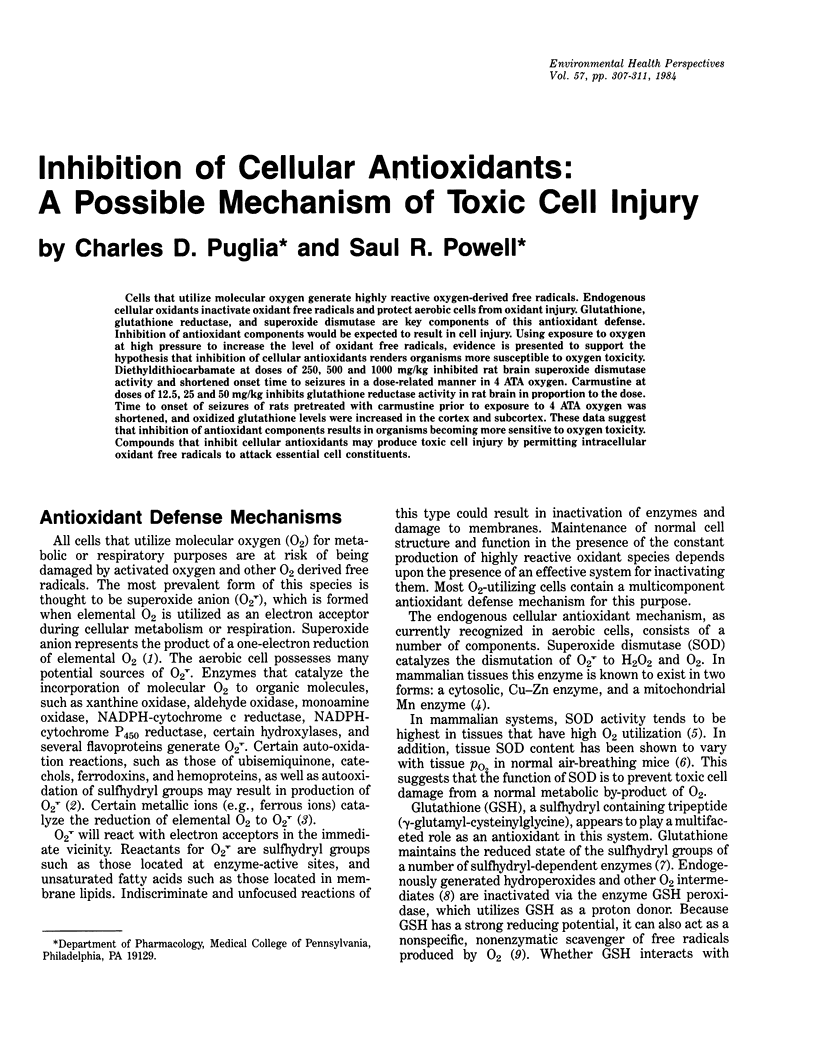
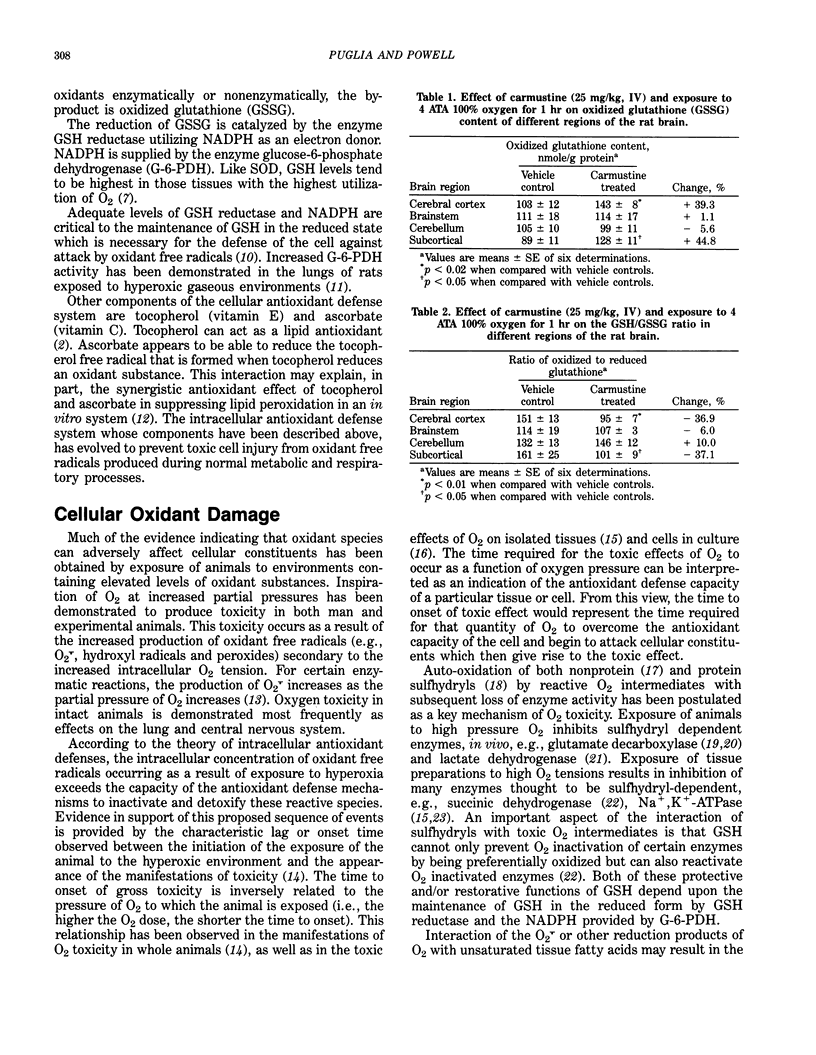
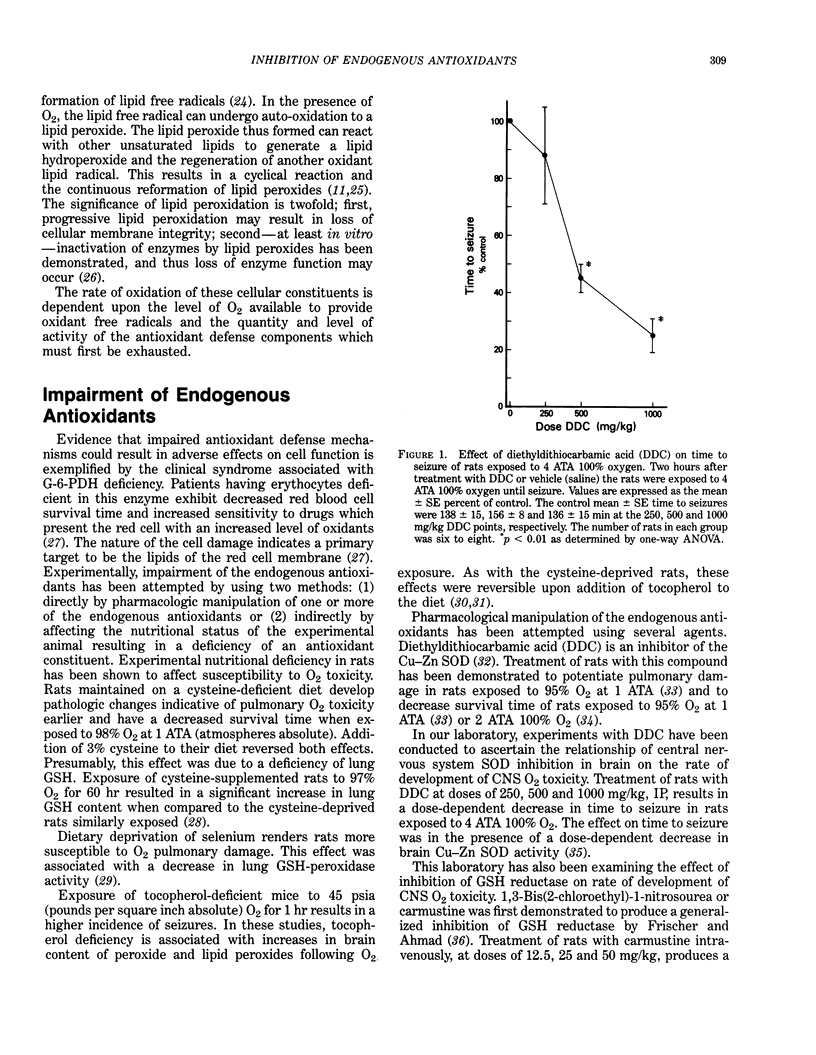
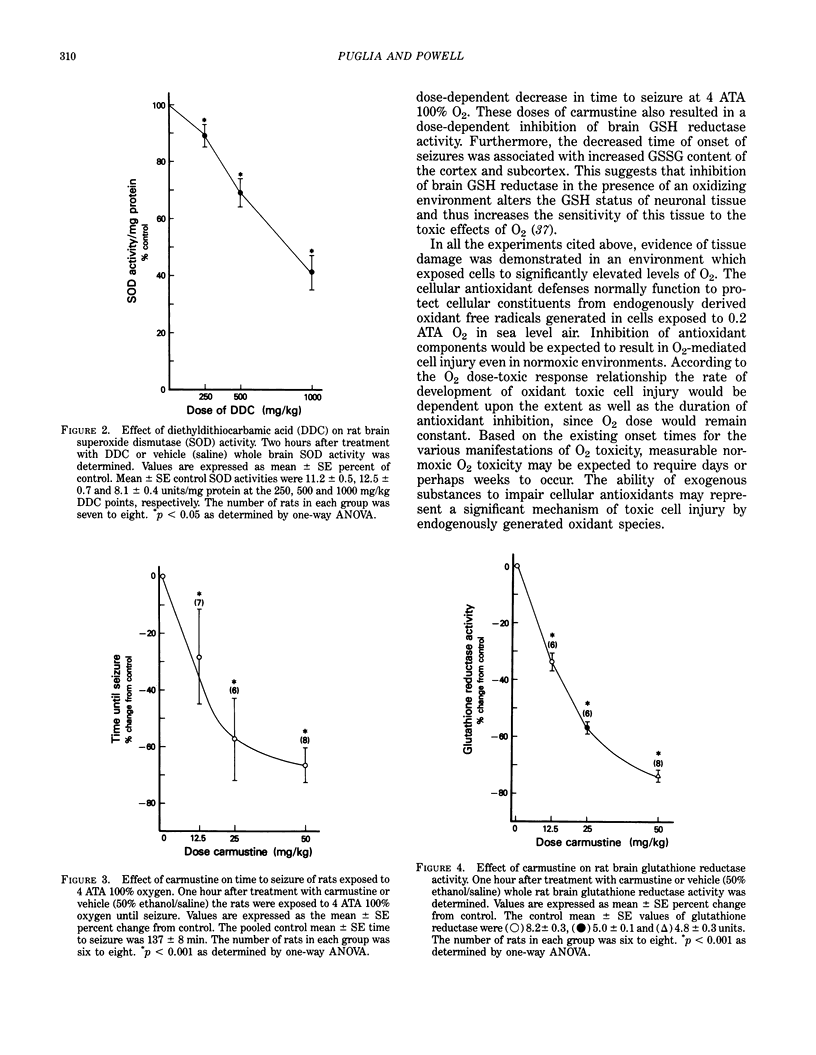
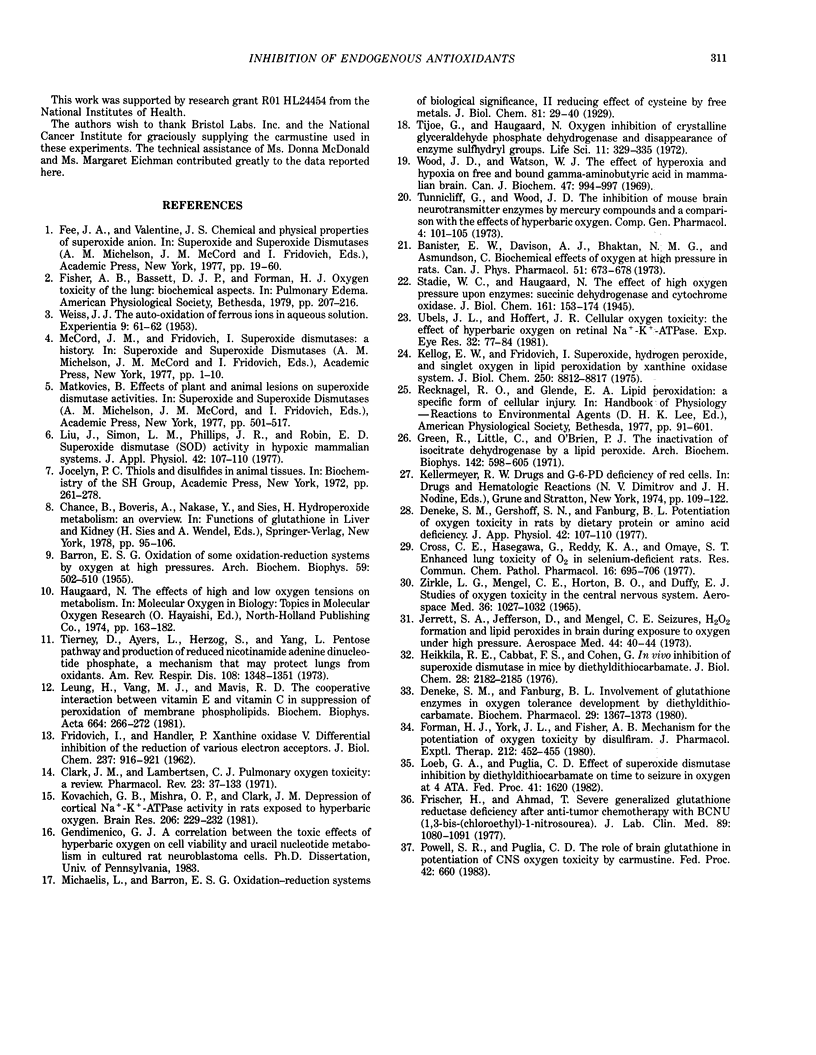
Selected References
These references are in PubMed. This may not be the complete list of references from this article.
- Banister E. W., Davison A. J., Bhakthan N. M., Asmundson C. Biochemical effects of oxygen at high pressure in rats. Can J Physiol Pharmacol. 1973 Sep;51(9):673–678. doi: 10.1139/y73-101. [DOI] [PubMed] [Google Scholar]
- Clark J. M., Lambertsen C. J. Pulmonary oxygen toxicity: a review. Pharmacol Rev. 1971 Jun;23(2):37–133. [PubMed] [Google Scholar]
- Cross C. E., Hasegawa G., Reddy K. A., Omaye S. T. Enhanced lung toxicity of O2 in selenium-deficient rats. Res Commun Chem Pathol Pharmacol. 1977 Apr;16(4):695–706. [PubMed] [Google Scholar]
- Deneke S. M., Fanburg B. L. Involvement of glutathione enzymes in O2 tolerance development by diethyldithiocarbamate. Biochem Pharmacol. 1980 May 15;29(10):1367–1373. doi: 10.1016/0006-2952(80)90432-3. [DOI] [PubMed] [Google Scholar]
- FRIDOVICH I., HANDLER P. Xanthine oxidase. V. Differential inhibition of the reduction of various electron acceptors. J Biol Chem. 1962 Mar;237:916–921. [PubMed] [Google Scholar]
- Forman H. J., York J. L., Fisher A. B. Mechanism for the potentiation of oxygen toxicity by disulfiram. J Pharmacol Exp Ther. 1980 Mar;212(3):452–455. [PubMed] [Google Scholar]
- Frischer H., Ahmad T. Severe generalized glutathione reductase deficiency after antitumor chemotherapy with BCNU" [1,3-bis(chloroethyl)-1-nitrosourea]. J Lab Clin Med. 1977 May;89(5):1080–1091. [PubMed] [Google Scholar]
- GUZMAN BARRON E. S. Oxidation of some oxidation-reduction systems by oxygen at high pressures. Arch Biochem Biophys. 1955 Dec;59(2):502–510. doi: 10.1016/0003-9861(55)90516-6. [DOI] [PubMed] [Google Scholar]
- Green R. C., Little C., O'Brien P. J. The inactivation of isocitrate dehydrogenase by a lipid peroxide. Arch Biochem Biophys. 1971 Feb;142(2):598–605. doi: 10.1016/0003-9861(71)90524-8. [DOI] [PubMed] [Google Scholar]
- Heikkila R. E., Cabbat F. S., Cohen G. In vivo inhibition of superoxide dismutase in mice by diethyldithiocarbamate. J Biol Chem. 1976 Apr 10;251(7):2182–2185. [PubMed] [Google Scholar]
- Jerrett S. A., Jefferson D., Mengel C. E. Seizures, H 2 O 2 formation and lipid peroxides in brain during exposure to oxygen under high pressure. Aerosp Med. 1973 Jan;44(1):40–44. [PubMed] [Google Scholar]
- Kellogg E. W., 3rd, Fridovich I. Superoxide, hydrogen peroxide, and singlet oxygen in lipid peroxidation by a xanthine oxidase system. J Biol Chem. 1975 Nov 25;250(22):8812–8817. [PubMed] [Google Scholar]
- Kovachich G. B., Mishra O. P., Clark J. M. Depression of cortical Na+, K+-ATPase activity in rats exposed to hyperbaric oxygen. Brain Res. 1981 Feb 9;206(1):229–232. doi: 10.1016/0006-8993(81)90122-0. [DOI] [PubMed] [Google Scholar]
- Leung H. W., Vang M. J., Mavis R. D. The cooperative interaction between vitamin E and vitamin C in suppression of peroxidation of membrane phospholipids. Biochim Biophys Acta. 1981 May 22;664(2):266–272. doi: 10.1016/0005-2760(81)90049-7. [DOI] [PubMed] [Google Scholar]
- Liu J., Simon L. M., Phillips J. R., Robin E. D. Superoxide dismutase (SOD) activity in hypoxic mammalian systems. J Appl Physiol Respir Environ Exerc Physiol. 1977 Jan;42(1):107–110. doi: 10.1152/jappl.1977.42.1.107. [DOI] [PubMed] [Google Scholar]
- Tierney D., Ayers L., Herzog S., Yang J. Pentose pathway and production of reduced nicotinamide adenine dinucleotide phosphate. A mechanism that may protect lungs from oxidants. Am Rev Respir Dis. 1973 Dec;108(6):1348–1351. doi: 10.1164/arrd.1973.108.6.1348. [DOI] [PubMed] [Google Scholar]
- Ubels J. L., Hoffert J. R. Ocular oxygen toxicity: the effect of hyperbaric oxygen on retinal Na+-K+ ATPase. Exp Eye Res. 1981 Jan;32(1):77–84. doi: 10.1016/s0014-4835(81)80041-3. [DOI] [PubMed] [Google Scholar]
- WEISS J. The autoxidation of ferrous ions in aqueous solution. Experientia. 1953 Feb 15;9(2):61–62. doi: 10.1007/BF02155128. [DOI] [PubMed] [Google Scholar]
- Wood J. D., Watson W. J. The effect of hyperoxia and hypoxia on free and bound gamma-aminobutyric acid in mammalian brain. Can J Biochem. 1969 Oct;47(10):994–997. doi: 10.1139/o69-159. [DOI] [PubMed] [Google Scholar]
- Zirkle L. G., Jr, Mengel C. E., Horton B. D., Duffy E. J. Studies of oxygen toxicity in the central nervous system. Aerosp Med. 1965 Nov;36(11):1027–1032. [PubMed] [Google Scholar]


